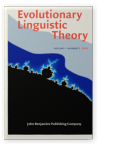Vol. 1:2 (2019) ► pp.109–142
What are the guiding principles in the evolution of language: Paradigmatics or syntagmatics?
The main designs of modern theories of syntax assume a process of syntagmatic organization. However, research on first language acquisition leaves no doubt that the structured combination of single lexical items cannot begin until a critical mass of lexical items has been acquired such that the lexicon is structured hierarchically on the basis of hierarchical feature bundling. Independent of a decision between the main views about the design of a proto language (the grammarless “Holophrastic view”, Arbib & Bickerton 2010: 1, Bickerton 2014) or the ‘Compositional View’ as taken by Rizzi (2010), Carstairs-McCarthy (2010), and others. What seems to be the minimal offset for language is the existence of grammatical categories like verb and noun, on the one hand, and, on the other hand, functional categories as needed for the expression of all kinds of agreement between the distinct categories to form recursively structured complexes. I follow the different stages of complexification asking whether there is paradigmatic next to syntagmatic organization and what its added value is for the evolution of grammar. The conclusion will be that paradigmatics is an indismissible part of the organization of early language in that it structures the lexicon so as to make primary and secondary syntactic merge possible and, consequently, is also a prerequisite for movement. The guiding idea of this position is Roman Jakobson’s insistence on the twofold organization of language and grammar. The two organizational designs, syntagmatics and paradigmatics, are manifest within each module: in the phonetic, the morphological, the syntactic, the semantic, and the pragmatic form (consider Jakobson’s 1971a, b reiterated argument).
Article outline
- Goal of this discussion
- 1.Introduction: What can be asked about L-evolution?
- 2.Methodological principles: Substituting the fossils
- 3.The Paradigmatics-before-Syntagmatics claim
- 4.Acquisition in terms of Paradigmaticity and Syntagmaticity
- 4.1First and subsequent acquisitional steps of structural organization
- 4.2From Paradigmatics to the inception of Syntagmatics
- 4.3When lexical timing is different from grammatical tensing
- 4.4According to which criteria are one-word utterances syntagmas?
- 4.5The late emergence of epistemics
- 5.Interim conclusion: What have we reached so far?
- 6.Early primary merge?
- 7.Double displacement of Bühler’s origo implementing Theory of mind
- 8.Phasal Expansions
- 9.An article-aspect (definiteness-background) conspiracy?
- 10.The evolutionary view with respect to P-before S vs. S-before-P
- 11.Conclusion
- Acknowledgements
- Notes
-
References
